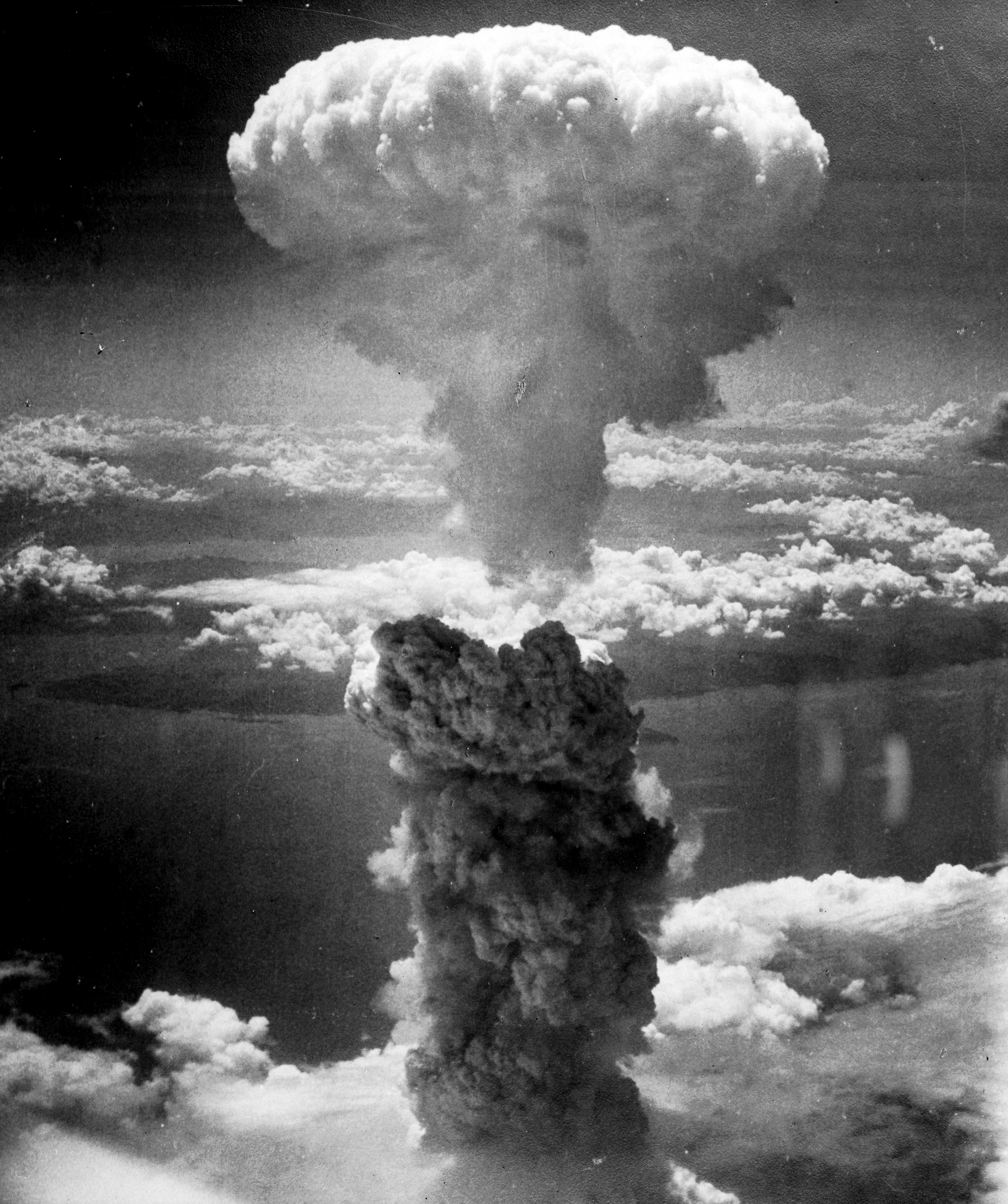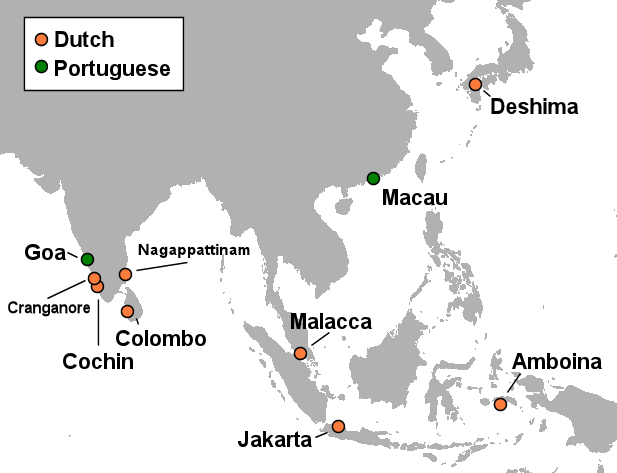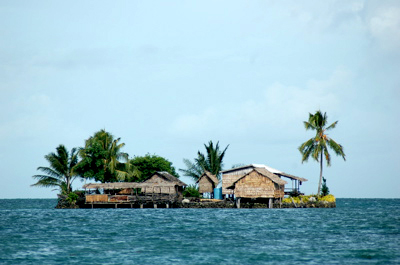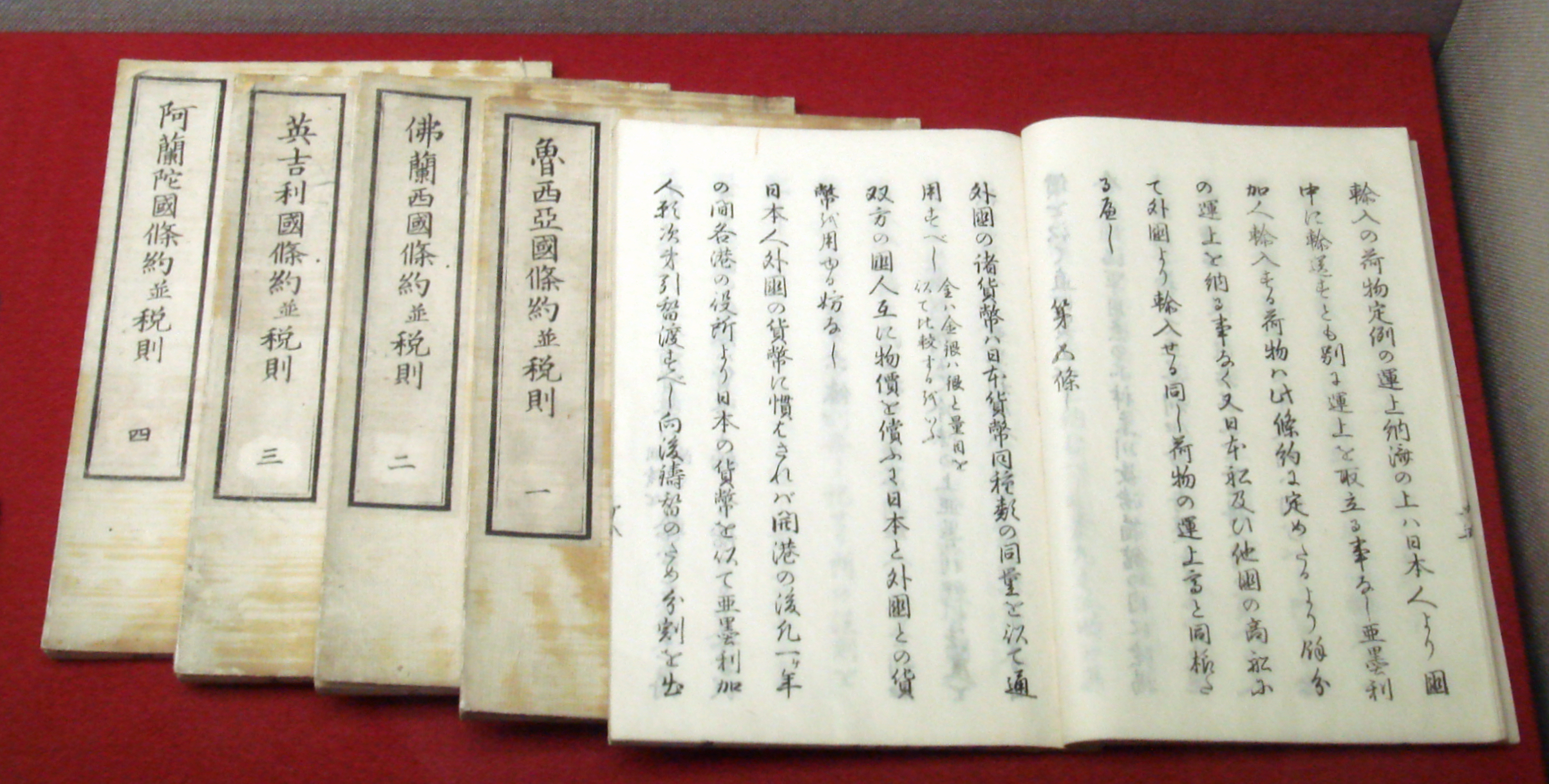|
Dejima
or Deshima, in the 17th century also called , was an artificial island off Nagasaki, Japan, that served as a trading post for the Portuguese (1570–1639) and subsequently the Dutch (1641–1858). For 220 years, it was the central conduit for foreign trade and cultural exchange with Japan during the isolationist Edo period (1600–1869), and the only Japanese territory open to Westerners. Spanning or , Dejima was created in 1636 by digging a canal through a small peninsula and linking it to the mainland with a small bridge. The island was constructed by the Tokugawa shogunate, whose isolationist policies sought to preserve the existing sociopolitical order by forbidding outsiders from entering Japan while prohibiting most Japanese from leaving. Dejima housed European merchants and separated them from Japanese society while still facilitating lucrative trade with the West. Following a rebellion by mostly Catholic converts, the Portuguese were expelled in 1639. The ... [...More Info...] [...Related Items...] OR: [Wikipedia] [Google] [Baidu] |
Rangaku
''Rangaku'' (Kyūjitai: , ), and by extension , is a body of knowledge developed by Japan through its contacts with the Dutch enclave of Dejima, which allowed Japan to keep abreast of Western technology and medicine in the period when the country was closed to foreigners from 1641 to 1853 because of the Tokugawa shogunate's policy of national isolation (sakoku). Through Rangaku, some people in Japan learned many aspects of the scientific and technological revolution occurring in Europe at that time, helping the country build up the beginnings of a theoretical and technological scientific base, which helps to explain Japan's success in its radical and speedy modernization following the forced American opening of the country to foreign trade in 1854. History The Dutch traders at Dejima in Nagasaki were the only Europeans tolerated in Japan from 1639 until 1853 (the Dutch had a trading post in Hirado from 1609 till 1641 before they had to move to Dejima), and their movements ... [...More Info...] [...Related Items...] OR: [Wikipedia] [Google] [Baidu] |
Sakoku
is the most common name for the isolationist foreign policy of the Japanese Tokugawa shogunate under which, during the Edo period (from 1603 to 1868), relations and trade between Japan and other countries were severely limited, and almost all foreign nationals were banned from entering Japan, while common Japanese people were kept from leaving the country. The policy was enacted by the shogunate government ('' bakufu'') under Tokugawa Iemitsu through a number of edicts and policies from 1633 to 1639. The term originates from the manuscript work written by Japanese astronomer and translator Shizuki Tadao in 1801. Shizuki invented the word while translating the works of the 17th-century German traveller Engelbert Kaempfer namely, his book, 'the history of Japan', posthumously released in 1727. Japan was not completely isolated under the policy. was a system in which strict regulations were placed on commerce and foreign relations by the shogunate and certain feudal domains ... [...More Info...] [...Related Items...] OR: [Wikipedia] [Google] [Baidu] |
Isaac Titsingh
Isaac Titsingh FRS ( January 1745 – 2 February 1812) was a Dutch diplomat, historian, Japanologist, and merchant.Nussbaum, Louis-Frédéric. (2005). "Isaak Titsingh" in . During a long career in East Asia, Titsingh was a senior official of the Dutch East India Company (). He represented the European trading company in exclusive official contact with Tokugawa Japan, traveling to Edo twice for audiences with the shogun and other high bakufu officials. He was the Dutch and VOC governor general in Chinsura, Bengal.Stephen R. Platt, ''Imperial Twilight: the Opium War and the End of China's Last Golden Age'' (NY: Knopf, 2018), 166-73. Titsingh worked with his counterpart, Charles Cornwallis, who was governor general of the British East India Company. In 1795, Titsingh represented Dutch and VOC interests in China, where his reception at the court of the Qing Qianlong Emperor stood in contrast to the rebuff suffered by British diplomat George Macartney's mission in 1793, just ... [...More Info...] [...Related Items...] OR: [Wikipedia] [Google] [Baidu] |
Nagasaki
, officially , is the capital and the largest Cities of Japan, city of Nagasaki Prefecture on the island of Kyushu in Japan. Founded by the Portuguese, the port of Portuguese_Nagasaki, Nagasaki became the sole Nanban trade, port used for trade with the Portuguese and Dutch during the 16th through 19th centuries. The Hidden Christian Sites in the Nagasaki Region have been recognized and included in the World Heritage Sites in Japan, UNESCO World Heritage Sites list. Part of Nagasaki was home to a major Imperial Japanese Navy base during the First Sino-Japanese War and Russo-Japanese War. Near the end of World War II, the American atomic bombings of Hiroshima and Nagasaki made Nagasaki the second city in the world to experience a nuclear attack. The city was rebuilt. , Nagasaki has an estimated population of 392,281, and a population density of 966 people per km2. The total area is . History Nagasaki as a Jesuit port of call The first recorded contact between Portuguese e ... [...More Info...] [...Related Items...] OR: [Wikipedia] [Google] [Baidu] |
Nagasaki Dejima C1771
, officially , is the capital and the largest city of Nagasaki Prefecture on the island of Kyushu in Japan. Founded by the Portuguese, the port of Nagasaki became the sole port used for trade with the Portuguese and Dutch during the 16th through 19th centuries. The Hidden Christian Sites in the Nagasaki Region have been recognized and included in the UNESCO World Heritage Sites list. Part of Nagasaki was home to a major Imperial Japanese Navy base during the First Sino-Japanese War and Russo-Japanese War. Near the end of World War II, the American atomic bombings of Hiroshima and Nagasaki made Nagasaki the second city in the world to experience a nuclear attack. The city was rebuilt. , Nagasaki has an estimated population of 392,281, and a population density of 966 people per km2. The total area is . History Nagasaki as a Jesuit port of call The first recorded contact between Portuguese explorers and Japan occurred in 1543, when a Portuguese ship, possibly a Chinese j ... [...More Info...] [...Related Items...] OR: [Wikipedia] [Google] [Baidu] |
Edo Period
The , also known as the , is the period between 1600 or 1603 and 1868 in the history of Japan, when the country was under the rule of the Tokugawa shogunate and some 300 regional ''daimyo'', or feudal lords. Emerging from the chaos of the Sengoku period, the Edo period was characterized by prolonged peace and stability, urbanization and economic growth, strict social order, Isolationism, isolationist foreign policies, and popular enjoyment of Japanese art, arts and Culture of Japan, culture. In 1600, Tokugawa Ieyasu prevailed at the Battle of Sekigahara and established hegemony over most of Japan, and in 1603 was given the title ''shogun'' by Emperor Go-Yōzei. Ieyasu resigned two years later in favor of his son Tokugawa Hidetada, Hidetada, but maintained power, and defeated the primary rival to his authority, Toyotomi Hideyori, at the Siege of Osaka in 1615 before his death the next year. Peace generally prevailed from this point on, making samurai largely redundant. Tokugawa sh ... [...More Info...] [...Related Items...] OR: [Wikipedia] [Google] [Baidu] |
Dutch Empire
The Dutch colonial empire () comprised overseas territories and trading posts under some form of Dutch control from the early 17th to late 20th centuries, including those initially administered by Dutch chartered companies—primarily the Dutch East India Company (1602–1799) and Dutch West India Company (1621–1792)—and subsequently governed by the Dutch Republic (1581–1795) and modern Kingdom of the Netherlands (1815–1975). Following the ''de facto'' independence of the Dutch Republic from the Spanish Empire in the late 16th century, various trading companies known as '' voorcompagnie'' led maritime expeditions overseas in search of commercial opportunities. By 1600, Dutch traders and mariners had penetrated the lucrative Asian spice trade but lacked the capital or manpower to secure or expand their ventures; this prompted the States General in 1602 to consolidate several trading enterprises into the semi-state-owned Dutch East India Company (, VOC), which was g ... [...More Info...] [...Related Items...] OR: [Wikipedia] [Google] [Baidu] |
Artificial Island
An artificial island or man-made island is an island that has been Construction, constructed by humans rather than formed through natural processes. Other definitions may suggest that artificial islands are lands with the characteristics of human intervention in their formation process, while others argue that artificial islands are created by expanding existing islets, constructing on existing reefs, or amalgamating several islets together. Although constructing artificial islands is not a modern phenomenon, there is no definite legal definition of it. Artificial islands may vary in size from small islets reclaimed solely to support a single pillar of a building or structure to those that support entire communities and cities. Archaeology, Archaeologists argue that such islands were created as far back as the Neolithic, Neolithic era. Early artificial islands included floating island, floating structures in still waters or wooden or megalithic structures erected in Ocean bank, s ... [...More Info...] [...Related Items...] OR: [Wikipedia] [Google] [Baidu] |
1858 Treaty Of Amity And Commerce Between The Netherlands And Japan
The Treaty of Amity and Commerce between Japan and the Netherlands (日蘭修好通商条約, Nichiran Shūkō Tsūshō Jōyaku) was signed between the Netherlands and Tokugawa Shogunate in Edo (now Tokyo) on August 18, 1858. It opened several Japanese ports and cities for Dutch trade and confirmed extraterritoriality to Dutch nationals in Japan. It was one of the so-called Ansei Treaties. Background On 31 March 1854, the United States of America succeeded in concluding a treaty with the Japanese Shogunate, called the Convention of Kanagawa or Perry Treaty. As a consequence, the US had the right to establish a consulate in the coastal town of Shimoda. The first US Consul at Shimoda was Townsend Harris, who arrived in Shimoda on 21 August 1856. Great Britain succeeded in concluding a similar convention with the Shogunate on 14 October 1854. Russia concluded a treaty with Japan on 7 February 1855. The Russian Treaty bore basic elements of extraterritoriality for both Russ ... [...More Info...] [...Related Items...] OR: [Wikipedia] [Google] [Baidu] |
Tokugawa Shogunate
The Tokugawa shogunate, also known as the was the military government of Japan during the Edo period from 1603 to 1868. The Tokugawa shogunate was established by Tokugawa Ieyasu after victory at the Battle of Sekigahara, ending the civil wars of the Sengoku period following the collapse of the Ashikaga shogunate. Ieyasu became the ''shōgun,'' and the Tokugawa clan governed Japan from Edo Castle in the eastern city of Edo (Tokyo), Edo (Tokyo) along with the ''daimyō'' lords of the ''samurai'' class. The Tokugawa shogunate organized Japanese society under the strict Edo society, Tokugawa class system and banned most foreigners under the isolationist policies of ''Sakoku'' to promote political stability. The Tokugawa shoguns governed Japan in a feudal system, with each ''daimyō'' administering a ''Han system, han'' (feudal domain), although the country was still nominally organized as provinces of Japan, imperial provinces. Under the Tokugawa shogunate, Japan experienced rapid ... [...More Info...] [...Related Items...] OR: [Wikipedia] [Google] [Baidu] |
Shimabara Rebellion
The , also known as the or , was an rebellion, uprising that occurred in the Shimabara Domain of the Tokugawa shogunate in Japan from 17 December 1637 to 15 April 1638. Matsukura Katsuie, the ''daimyō'' of the Shimabara Domain, enforced unpopular policies set by his father Matsukura Shigemasa that drastically raised taxes to construct the new Shimabara Castle and violently prohibited Christianity. In December 1637, an alliance of local ''rōnin'' and mostly Kirishitan, Catholic peasants led by Amakusa Shirō rebelled against the Tokugawa shogunate due to discontent over Katsuie's policies. The Tokugawa shogunate sent a force of over 125,000 troops supported by the Dutch colonial empire, Dutch to suppress the rebels, which defeated the rebels after a lengthy siege against their stronghold at Hara Castle in Minamishimabara. Following the successful suppression of the rebellion, Shirō and an estimated 37,000 rebels and sympathizers were Decapitation, beheaded, and the Nanban tr ... [...More Info...] [...Related Items...] OR: [Wikipedia] [Google] [Baidu] |








